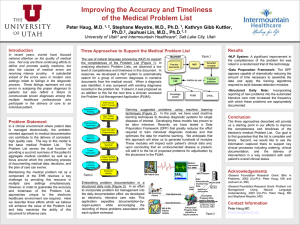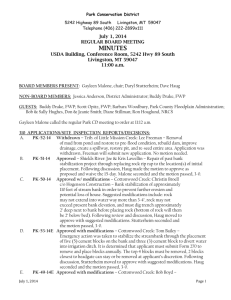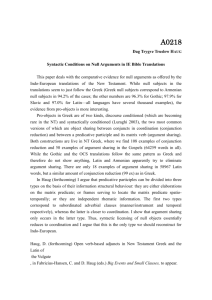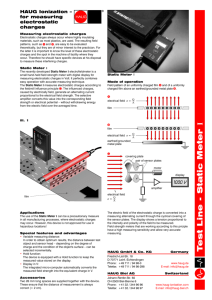Fourier transform infrared spectroscopy (FTIR) for semiconductor material characterization Halvard Haug, 04.10.2010
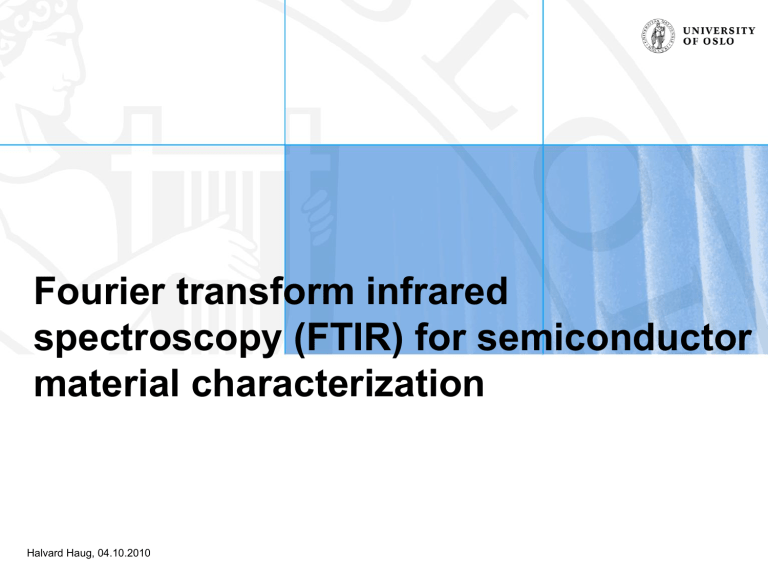
Fourier transform infrared spectroscopy (FTIR) for semiconductor material characterization
Halvard Haug, 04.10.2010
Outline
• Introduction
• Theory
– Localized vibrational modes
– Infrared transmission spectroscopy
– The Michelson interferometer
• Advantages and limitations of FTIR
• The FTIR in MiNaLab
• Some examples of results
– Defects in irradiated Si
– H impurities in ZnO
– Bond concentrations in SiN x
films
• Summary
Halvard Haug, 04.10.2010
Suggested reading
• Schroder, D. K: Semiconductor material and device characterization, section 10.4 (page 585 – 592)
Halvard Haug, 04.10.2010
Molecular vibrations
Halvard Haug, 04.10.2010
May absorb IR radiation with a characteristic energy if the bond has a time-varying dipole moment
IR active vibrational modes
Not IR active
IR active
Halvard Haug, 04.10.2010
Vibrational modes in crystals
Phonons
Acoustical modes
(not IR active):
Optical modes
(IR active):
Halvard Haug, 04.10.2010
Vibrational modes in crystals
Point defects
• Destroy the translational symmetry of the lattice, altering the normal modes of vibration.
• If the frequency of the modified mode lies outside the phonon bands we get a localized vibrational mode
(LVM)
• LVMs absorb IR radiation at a characteristic frequency determined by the local atomic configuration
Halvard Haug, 04.10.2010
Infrared spectroscopy of solids
• Absorption mechanisms
– Optical phonon absorption
– Localized vibrational modes
– Free electron absorption
– Internal electronic transitions in (impurity) atoms
– (Band-to-band absorption ++)
Halvard Haug, 04.10.2010
Infrared spectroscopy
• Wave number:
Transmittance
Halvard Haug, 04.10.2010
Absorption coefficient
Infrared spectroscopy
• Including reflection:
Halvard Haug, 04.10.2010
Infrared spectroscopy
• Including reflection:
Halvard Haug, 04.10.2010
Infrared spectroscopy
• Separate absorption from lattice/free electrons ( α
1
) and defects ( α
2
):
Halvard Haug, 04.10.2010
Infrared spectroscopy
• known from defectfree reference or may be substracted
• Calculate α
2
from T
Halvard Haug, 04.10.2010
Infrared spectroscopy
Beers law:
The (integrated) absorption coefficient is proportional to the concentration of absorbing species:
Halvard Haug, 04.10.2010
The Michelson interferometer
Stationary mirror
Beamsplitter
Source
Movable mirror
Halvard Haug, 04.10.2010
Detector
The Michelson interferometer
Stationary mirror
Beamsplitter
Source
Movable mirror
Halvard Haug, 04.10.2010
Detector
The Michelson interferometer
Stationary mirror
Beamsplitter
Source
Movable mirror
Halvard Haug, 04.10.2010
Detector
The Michelson interferometer
Stationary mirror
Source
Halvard Haug, 04.10.2010
Beamsplitter
Optical path length difference
Interference
Detector
Movable mirror
Single wavelength source
Constructive interference for
And destructive interference for
Intensity as a function of OPD:
Halvard Haug, 04.10.2010
Multiple wavelength source
Halvard Haug, 04.10.2010
Continuous source
Interferogram
Halvard Haug, 04.10.2010
Fourier transformation
Interferogram:
Spectrum:
FT
Halvard Haug, 04.10.2010
Interference from sample surfaces n d
Constructive interference for:
Sinusoidal ”noise” over the
whole spectrum
Halvard Haug, 04.10.2010
Interference from sample surfaces d
Constructive interference for:
Sinusoidal ”noise” over the
whole spectrum
Halvard Haug, 04.10.2010
Advantages of FTIR over dispersive spectrometers
• All resolution elements are measured all of the time
– Higher signal-to-noise-ratio (SNR) for a given measurement time and resolution
• Higher optical throughoutput
– Better SNR and sensitivity
• Short measurement time (~1-3 s) and possibility for signal averaging
– Quick measurement or high SNR
• High resolution by increasing δ max
– MiNaLab: Δ = 0.01 cm-1
• Internal wavenumber calibration system
Halvard Haug, 04.10.2010
Limitations of FTIR
• Must have a time-varying dipole moment
• Sample must be (partially) transparent to IR
Samples must not be too conductive
(For Si: ~1 Ωcm)
• Need sufficient absorption length (For Si: ~mm)
• Need conversion factor for good quantitative analysis
• ”Single-beam technique” Background and sample spectra measured at different times
• Detection limits typically 10 13 – 10 15 cm -3
Halvard Haug, 04.10.2010
The FTIR in MiNaLab
Name
Geometry
Spectral range
Bruker Optics - 125HR
Transmission
5 cm -1 to 50 000 cm -1
Max OPD
Resolution
50 cm
Resolves lines down to 0.001 cm -1
Sample temperature ~ 15 K or RT
Halvard Haug, 04.10.2010
The FTIR in MiNaLab
Halvard Haug, 04.10.2010
Case 1:
Investigation of oxygen-related complexes in irradiated Cz silicon
With thanks to Leonid Murin,
Joint Institute of Solid State and Semiconductor Physics,
Minsk, Belarus
Halvard Haug, 04.10.2010
0.5
T = 300 K (Bruker IFS 113v)
0.4
0.3
0.2
0.1
Background (without sample)
Raw spectrum, FZ-Si, d = 3 mm
Raw spectrum
Cz-3-J4, 24 GeV p-irr 1E16, d = 3 mm
0.0
400 600 800 1000 1200 1400
Wavenumber, cm
-1
1600 1800 2000
Halvard Haug, 04.10.2010
0.4
0.3
0.2
0.1
0.0
400
T = I / I
0.6
T = 300 K (Bruker IFS 113v)
0.5
FZ-Si, d = 3 mm
600
CZ-Si, 24 GeV p-irr 1x10
16 cm
-2
, d = 3 mm
800 1000 1200 1400
Wavenumber, cm
-1
1600 1800 2000
Halvard Haug, 04.10.2010
3
4
T = 300 K (Bruker IFS 113v)
A = αd = -ln(I/I
0
)
0
)
2
1
0
400 600
CZ-Si, 24 GeV p-irr 1x10
16 cm
-2
, d = 3 mm
FZ-Si, d = 3 mm
800 1000 1200 1400
Wavenumber, cm
-1
1600 1800 2000
Halvard Haug, 04.10.2010
- A ref
/I
0
))
1.2
T = 300 K (Bruker IFS 113v)
1.0
0.8
0.6
0.4
0.2
0.0
400 600
CZ-Si, 24 GeV p-irr 1x10
16 cm
-2
, d = 3 mm
800 1000 1200 1400
Wavenumber, cm
-1
1600 1800 2000
Halvard Haug, 04.10.2010
α = A/d
4.0
3.5
T = 300 K (Bruker IFS 113v)
3.0
2.5
2.0
1.5
1.0
0.5
0.0
400 600 800
N
O
= 1.06x10
18
cm
-3
CZ-Si, 24 GeV p-irr 1x10
16 cm
-2
, d = 3 mm
1000 1200 1400
Wavenumber, cm
-1
1600 1800 2000
Halvard Haug, 04.10.2010
α = A/d
0.40
0.38
0.36
0.34
0.32
0.30
0.28
0.26
0.24
0.22
0.20
800
T = 300 K (Bruker IFS 113v)
N
VO
= 8.5x10
15
cm
-3
850
I
2
O
CZ-Si, 24 GeV p-irr 1x10
16 cm
-2
, d = 3 mm
1000 900 950
Wavenumber, cm
-1
Halvard Haug, 04.10.2010
1050
α – α
0.45
VO
0.40
I
2
O
0.35
0.30
IO
2
, I
2
O
2
CZ-Si, 24 GeV p-irr 1x10
16 cm
-2
, d = 3 mm
O
2i
IO
2
, I
2
O
2
O
2i
0.25
T = 300 K
0.20
800 850
O i
1100 900 950 1000
Wavenumber, cm
-1
1050
Halvard Haug, 04.10.2010
1150
0.8
0.6
0.4
0.2
0.0
-0.2
800
V
2
O
2
VO
850
C i
O i
VO
-
α, low temperature
1 - Cz1-I4 ([C
S
= 5x10
16
cm
2 - Cz3-J4 ([C
S
< 1x10
15
cm
-3
) RT irr 1x10
16
cm
-2
p
+
26 GeV
-3
) RT irr 1x10
16
cm
-2
p
+
26 GeV
3 - Cz3-J3 ([C
S
< 1x10
15
cm
-3
) DAC: RT irr 1x10
16
cm
-2
p
+
26 GeV - hot irr
IC i
O i
IC i
1
18
O i
I
2
O
2
IO
2
I
2
O
2
IO
2
I
2
O
2
3
O
2i
O
2i
VO
2
900 950
Wavenumber, cm
-1
1000 1050
T = 20 K
1100
Halvard Haug, 04.10.2010
Case 2:
Hydrogen-related defects in hydrothermally grown ZnO
Halvard Haug, 04.10.2010
Hydrogen in ZnO
• H is an important impurity in ZnO, present during crystal growth
• Interstitial (free) H acts as a donor, independent of EF
• May also passivate acceptors
Contributing to inherent n-type conductivity
• H forms strong O-H bonds in the ZnO structure
Localized vibrational modes
Frequency in the range ~3200-3600 cm-1 (close to that of
the free O-H bond), characteristic of the atomic environment
FTIR a useful tool to study OH-related complexes
Halvard Haug, 04.10.2010
Isotopic shifts
• O-H vibrational mode modeled as an harmonic oscillator
• Predicted frequency shift of when D (m = 2 amu) is substituted for H (m = 1 amu)
• Similar shifts observed in experiments used for identification of
H-related absorption lines
Halvard Haug, 04.10.2010
As-grown spectra
H-? OH-Li
Zn
Ni
Zn
Halvard Haug, 04.10.2010
Spectrum after treatment in H
2
/D
2
gas
1.35 O-H
H-Y
H-Y
H-X
H-X
Halvard Haug, 04.10.2010
H-X, thermal stability
E a
= 2.8 eV t = 30 min
Halvard Haug, 04.10.2010
H-X, molecular model
• Defect complex with an impurity atom and two O-
H bonds
• Mg, Fe, Si ? c-akse
Halvard Haug, 04.10.2010
Case 3:
Determination of bond concentrations and
Si/N-ratio in a-SiN x
:H dielectric thin films
Figures from
Wright et. al., ”Plasma-enhanced chemical vapour-deposited silicon nitride films; The effect of annealing on optical properties and etch rates”, Solar
Energy Materials & Solar Cells (2008)
Halvard Haug, 04.10.2010
Halvard Haug, 04.10.2010
Halvard Haug, 04.10.2010 n(633 nm)
Summary
• Defects in a crystal material may give rise to localized vibrational modes (LVMs) that absorb IR radiation at a characteristic frequency
• FTIR is a relatively simple, non-destructive tool suitable for studying such LVMs and other material properties
• Both qualitative and quantitative (with conversion factors) investigations are possible
• Samples must be thick enough for sufficient absorption and transparent in the IR-range (not too conductive)
Halvard Haug, 04.10.2010

